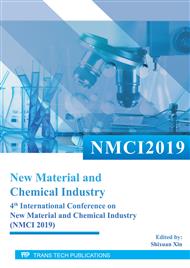[1]
Varela F E, Gassa L M, Vilche J R. Influence of Temperature on Electroreduction of Anodically Formed Passive Fams on Lead Electrodes in H2S04 Solutions. Part I: Electroreduction of PbS04 Layers [J]. Journal of Applied Electrochemistry. 1995,25:358-363.
DOI: 10.1007/bf00249655
Google Scholar
[2]
Ken S, Takayuki F, Masashi W, et al. Development of Additives in Negative Active-Material to Suppress Sulfation during High-Rate Partial State of Charge Operation of Lead-Acid Batteries [J]. J. Power Sources. 2006,158:1084- 1090.
DOI: 10.1016/j.jpowsour.2006.01.096
Google Scholar
[3]
Boden D P. Hammond lead Products, A Division of Hammond Group, 2323 165th Street, Hammond, IN 46325. USA. Comparison of Methods for Adding Expander to Lead-Battery Plates-Advantages and Disadvantages [J]. J. Power Sources. 2006,133:47- 51.
DOI: 10.1016/j.jpowsour.2003.12.006
Google Scholar
[4]
Cooper A. Development of a Lead-Acid Battery for a Hybrid Electric Vehicle Journal of Power Sources, 2004,133:116-125.
DOI: 10.1016/j.jpowsour.2003.11.069
Google Scholar
[5]
Valenciano J, Fernandez M, Trinidad F, et al. Lead-Acid Batteries for Micro-and Mild-Hybrid Applications [J]. J. Power Sources. 2009,187:599-613.
DOI: 10.1016/j.jpowsour.2008.11.089
Google Scholar
[6]
Saravanan M, Ganesan M, Ambalavanan S. An in Situ-generated Carbon as Integrated Conductive Additive for Hierarchical Negative Plate of Lead-Acid Battery [J ]. J. Power Sources. 2014,251:20-34.
DOI: 10.1016/j.jpowsour.2013.10.143
Google Scholar
[7]
Moseley P T, Nelson R F, Hollenkamp A F. The Role of Carbon in Valve-Regulated Lead-Acid Battery Technology [J]. J Power Sources. 2006,157(1):3-14.
DOI: 10.1016/j.jpowsour.2006.02.031
Google Scholar
[8]
Wu Xianzhang, Chen Jian, Xiang Jiayuan, et al. Key technologies and research progress of lead carbon battery [S]. China communication energy conference. Power supply equipment: 2012 -2012:384-389. (In Chinese).
Google Scholar
[9]
Fernandez M, Trinidad F, Valenciano J, et al. Optimization of the Cycle Life Performance of VRLA Batteries, Working under High Rate, Partial State of Charge (HRPSOC) Conditions [J]. J. Power Sources. 2006,158:1149-1160.
DOI: 10.1016/j.jpowsour.2006.03.025
Google Scholar
[10]
Pavlov D, Nikolov P, Rogachev T. Influence of Expander Components on the Processes at the Negatives of Lead-Acid Cells on High-Rate Partial-State-of-Charge Cycling. Part II. Effect of carbon additives on the processes of charge and discharge of negative plates [J]. J. Power Sources. 2010,195:4444-4457.
DOI: 10.1016/j.jpowsour.2009.12.132
Google Scholar
[11]
ALABC Research Project C1.1/2.1A Final Report: Identification of the Optimum Specification for Carbon to be Included in the Negative Active Material of a Valve-Regulated Battery in Order to Avoid Accumulation of Lead Sulfate During High-Rate Partial-State-of-Charge Operation. Durham, NC. 2010:1156-1176.
Google Scholar
[12]
Newnham R H, Baldsing W G A, Hollenkamp A F, et al. ALABC Project C/N1.1. Advancement of Valve-Regulated Lead-Acid Battery Technology for Hybridelectric and Electric Vehicles, Final Report, July 2000 to June 2002 [R]. North Carolina, USA: Advanced Lead-Acid Battery Consortium, Research Triallgle Park. (2002).
DOI: 10.1109/bcaa.2000.838412
Google Scholar
[13]
Wang Bin, Zhang Hui, Zhang Lifang. Effect of carbon additives on the performance of VRLA batteries [J]. Batteries. 2015, 52(5):223-226. (In Chinese).
Google Scholar


